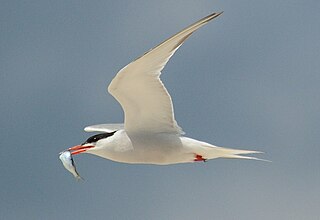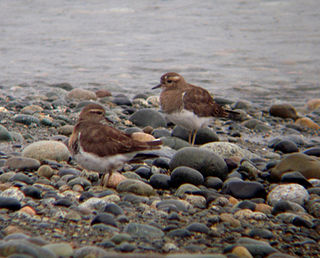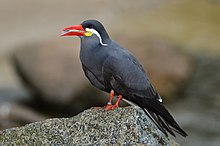
The common tern is a seabird in the family Laridae. This bird has a circumpolar distribution, its four subspecies breeding in temperate and subarctic regions of Europe, Asia and North America. It is strongly migratory, wintering in coastal tropical and subtropical regions. Breeding adults have light grey upperparts, white to very light grey underparts, a black cap, orange-red legs, and a narrow pointed bill. Depending on the subspecies, the bill may be mostly red with a black tip or all black. There are several similar species, including the partly sympatric Arctic tern, which can be separated on plumage details, leg and bill colour, or vocalisations.

The common gull or sea mew is a medium-sized gull that breeds in the Palearctic. The closely related short-billed gull is sometimes included in this species, which may be known collectively as "mew gull". Many common gulls migrate further south in winter. There are differing accounts as to how the species acquired its vernacular name.

The little gull, is a species of gull belonging to the family Laridae which is mainly found in the Palearctic with some colonies in North America. It breeds on freshwaters and spends winters at sea. It is the smallest species of gull in the world and the only species in the monospecific genus Hydrocoloeus.

The gull-billed tern, formerly Sterna nilotica, is a tern in the family Laridae. It is widely distributed and breeds in scattered localities in Europe, Asia, northwest Africa, and the Americas. The Australian gull-billed tern was previously considered a subspecies.

The royal tern is a tern in the family Laridae. The species is endemic to the Americas, though strays have been identified in Europe.

Forster's tern is a tern in the family Laridae. The genus name Sterna is derived from Old English "stearn", "tern", and forsteri commemorates the naturalist Johann Reinhold Forster.

The black skimmer is a tern-like seabird, one of three similar bird species in the skimmer genus Rynchops in the gull family Laridae. It breeds in North and South America. Northern populations winter in the warmer waters of the Caribbean and the tropical and subtropical Pacific and Atlantic coasts, but South American populations make only shorter movements in response to annual floods which extend their feeding areas in the river shallows.

The Antarctic tern is a seabird in the family Laridae. It ranges throughout the southern oceans and is found on small islands around Antarctica as well as on the shores of the mainland. Its diet consists primarily of small fish and crustaceans. It is very similar in appearance to the closely related Arctic tern, but it is stockier, and it is in its breeding plumage in the southern summer, when the Arctic tern has shed old feathers to get its non-breeding plumage. The Antarctic tern does not migrate like the Arctic tern does, but it can still be found on a very large range. This tern species is actually more closely related to the South American tern.

The stripe-breasted starthroat is a species of hummingbird in the "mountain gems", tribe Lampornithini in subfamily Trochilinae. It is endemic to Brazil.

The rufous-chested dotterel or rufous-chested plover, is a species of bird in subfamily Charadriinae of family Charadriidae. It is found in Argentina, Brazil, Chile, Uruguay, and the Falkland Islands.

The tawny-throated dotterel is a species of bird in the family Charadriidae, the plovers and their relatives. It is found in Argentina, Bolivia, Brazil, Chile, Peru, and Uruguay.

The grey-capped cuckoo is a species of bird in the tribe Phaenicophaeini, subfamily Cuculinae of the cuckoo family Cuculidae. It is found in Colombia, Ecuador, Peru, and Venezuela, as a vagrant on Bonaire and in the Galápagos Islands, and possibly in Panama.

The Andean gull is a species in subfamily Larinae of the family Laridae, the gulls, terns, and skimmers. It is found in Argentina, Bolivia, Chile, Colombia, Ecuador, and Peru.

The snowy-crowned tern, also known as Trudeau's tern, is a species of bird in subfamily Sterninae of the family Laridae, the gulls, terns, and skimmers. It is native to Argentina, Brazil, Chile, Uruguay, and possibly Paraguay, and also vagrant in Peru and the Falkland Islands.

The sharp-billed canastero or lesser canastero is a species of bird in the Furnariinae subfamily of the ovenbird family Furnariidae. It is found in Argentina, Bolivia, Chile, Paraguay, and Uruguay, and has also occurred as a vagrant in Brazil.

The buff-winged cinclodes is a species of bird in the Furnariinae subfamily of the ovenbird family Furnariidae. It is found in Argentina, Brazil, Chile, Paraguay, Uruguay and as a vagrant on the Falkland Islands.

The white-lored spinetail is a species of bird in the Furnariinae subfamily of the ovenbird family Furnariidae. It is found in Bolivia, Brazil, and Paraguay.

The yellow-browed woodpecker, also known as the white-browed woodpecker, is a Near Threatened species of bird in the woodpecker family Picidae. It is found in Argentina, Brazil, Paraguay, and Uruguay.

Cabot's tern is a species of bird in subfamily Sterninae of the family Laridae, the gulls, terns, and skimmers. It is found in the eastern U.S. and Middle America, the Caribbean, Trinidad and Tobago, and in every mainland South American country except Bolivia and Paraguay.

The Chiriqui foliage-gleaner is a species of bird in the Furnariinae subfamily of the ovenbird family Furnariidae. It is found in Costa Rica and Panama.



























